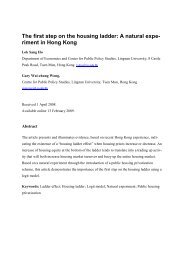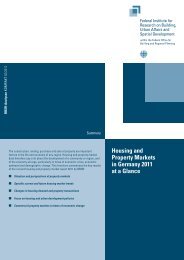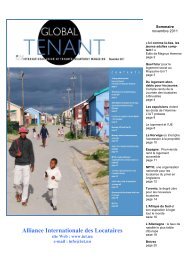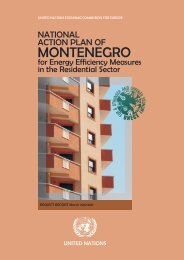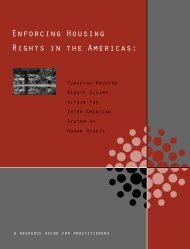affordable land and housing in asia - International Union of Tenants
affordable land and housing in asia - International Union of Tenants
affordable land and housing in asia - International Union of Tenants
- No tags were found...
Create successful ePaper yourself
Turn your PDF publications into a flip-book with our unique Google optimized e-Paper software.
can be found throughout Asian cities <strong>and</strong> arelargely f<strong>in</strong>anced <strong>and</strong> led by private developers.Impos<strong>in</strong>g advertisements abound for residentialproperty that is portrayed as comfortable <strong>and</strong>secure, <strong>and</strong> <strong>of</strong>ten provided with associatedmortgage f<strong>in</strong>ance for middle- <strong>and</strong> high-<strong>in</strong>comehousehold purchasers. Such <strong>hous<strong>in</strong>g</strong>, however,is simply out <strong>of</strong> f<strong>in</strong>ancial reach for the vastmajority <strong>of</strong> households <strong>and</strong> as a result, <strong>in</strong>formal<strong>hous<strong>in</strong>g</strong>, slums, squatter settlements, low-qualityrental <strong>hous<strong>in</strong>g</strong>, house shar<strong>in</strong>g <strong>and</strong> street sleep<strong>in</strong>gcont<strong>in</strong>ue to proliferate <strong>in</strong> most Asian cities.In Asian countries that have relatively strongeconomies <strong>and</strong> well function<strong>in</strong>g <strong>hous<strong>in</strong>g</strong>markets the present issue is not the cost <strong>of</strong><strong>hous<strong>in</strong>g</strong> per se but rather secur<strong>in</strong>g <strong>hous<strong>in</strong>g</strong>f<strong>in</strong>ance. Compared with Africa <strong>and</strong> Lat<strong>in</strong>America, the rapid economic development <strong>in</strong>Asia over the last several decades has led to largeeffective dem<strong>and</strong>, but the lack <strong>of</strong> <strong>hous<strong>in</strong>g</strong> f<strong>in</strong>anceis the major obstacle. Many households are ableto service a mortgage but they cannot get f<strong>in</strong>ance,<strong>of</strong>ten due to high down-payment requirements.In India, for example, there is considerablepotential at the lower-<strong>in</strong>come end <strong>of</strong> the <strong>hous<strong>in</strong>g</strong>market. Private developers can produce low-cost<strong>hous<strong>in</strong>g</strong> units, but they cannot sell them because<strong>of</strong> the lack <strong>of</strong> lower-<strong>in</strong>come f<strong>in</strong>ance options.There are 23 to 28 million middle- <strong>and</strong> lower<strong>in</strong>comehouseholds <strong>in</strong> urban India with <strong>in</strong>comesbetween 5,000 <strong>and</strong> 11,000 INR (112 to 248USD) that could meet <strong>hous<strong>in</strong>g</strong> repayments. 39Yet they are constra<strong>in</strong>ed as they cannot get creditto buy <strong>hous<strong>in</strong>g</strong>. While the poorest still can notafford such <strong>hous<strong>in</strong>g</strong>, exp<strong>and</strong><strong>in</strong>g <strong>hous<strong>in</strong>g</strong> f<strong>in</strong>anceto the group where there is effective dem<strong>and</strong>could potentially transform <strong>hous<strong>in</strong>g</strong> sector <strong>and</strong>economy. Likewise, <strong>in</strong> Bangladesh there is<strong>in</strong>terest from private developers <strong>in</strong> produc<strong>in</strong>g<strong>hous<strong>in</strong>g</strong> for low-<strong>in</strong>come households but ‘<strong>in</strong>the absence <strong>of</strong> fundamental improvements <strong>in</strong><strong>in</strong>frastructure, <strong>l<strong>and</strong></strong>, <strong>and</strong> <strong>hous<strong>in</strong>g</strong> development,this nascent trend will not go far’. 40 Smalladjustments to the <strong>hous<strong>in</strong>g</strong> unit price <strong>and</strong>mortgage terms would <strong>in</strong>crease the market to 40per cent <strong>of</strong> the urban population. This, aga<strong>in</strong>,highlights the importance <strong>of</strong> develop<strong>in</strong>g <strong>hous<strong>in</strong>g</strong>f<strong>in</strong>ance mechanisms to support low-<strong>in</strong>comehouseholds to secure <strong>hous<strong>in</strong>g</strong>.In light <strong>of</strong> this brief historical snapshot itis clear that while the challenge <strong>of</strong> <strong>hous<strong>in</strong>g</strong>affordability is not new, it is an <strong>in</strong>creas<strong>in</strong>gproblem <strong>in</strong> most Asian cities. Even with thesignificant theoretical, policy <strong>and</strong> practice shiftsover the last sixty years, <strong>in</strong>formal <strong>hous<strong>in</strong>g</strong> hascont<strong>in</strong>ued to play a lead<strong>in</strong>g role <strong>in</strong> deliver<strong>in</strong>gurban <strong>hous<strong>in</strong>g</strong> at a economic cost that thepoor can afford. While it may be economicallybeneficial, such <strong>in</strong>formal development is nota suitable method for deliver<strong>in</strong>g <strong>affordable</strong>,comfortable, <strong>and</strong> healthy <strong>hous<strong>in</strong>g</strong> consistentwith the susta<strong>in</strong>able <strong>and</strong> planned growth <strong>of</strong> cities<strong>and</strong> urban regions.Over the last sixty years the key challenges havenot notably changed. For households, the keymicro challenge for obta<strong>in</strong><strong>in</strong>g <strong>and</strong> reta<strong>in</strong><strong>in</strong>g<strong>affordable</strong> <strong>hous<strong>in</strong>g</strong> is access to <strong>affordable</strong> <strong>l<strong>and</strong></strong> <strong>and</strong><strong>hous<strong>in</strong>g</strong> f<strong>in</strong>ance. For governments, the key macrochallenge rema<strong>in</strong>s the need for governments to<strong>in</strong>stil a supportive <strong>in</strong>stitutional <strong>and</strong> regulatoryframework that can improve the affordability<strong>of</strong> <strong>hous<strong>in</strong>g</strong> <strong>and</strong> <strong>in</strong>crease its supply <strong>in</strong> face <strong>of</strong>cont<strong>in</strong>ued rapid urbanisation <strong>and</strong> populationgrowth.1.3 HOUSING AFFORDABILITY:ITS COMPONENTS ANDMEASURESAffordable <strong>hous<strong>in</strong>g</strong> is broadly def<strong>in</strong>ed as thatwhich is adequate <strong>in</strong> quality <strong>and</strong> location <strong>and</strong> doesnot cost so much that it prohibits its occupantsmeet<strong>in</strong>g other basic liv<strong>in</strong>g costs or threatens theirenjoyment <strong>of</strong> basic human rights. 41Hous<strong>in</strong>g affordability is affected by many factors.Figure 8 outl<strong>in</strong>es the components <strong>of</strong> <strong>hous<strong>in</strong>g</strong>affordability for households. Affordability ispr<strong>in</strong>cipally set by two ma<strong>in</strong> variables: capitalvariables (house purchase costs) <strong>and</strong> occupationvariables (costs associated with keep<strong>in</strong>g thehouse).The ability <strong>of</strong> a household to purchase a house isaffected by the purchase cost (which is the sumcost <strong>of</strong> <strong>l<strong>and</strong></strong>, <strong>in</strong>frastructure, build<strong>in</strong>g materials<strong>and</strong> labour <strong>and</strong> pr<strong>of</strong>it) <strong>and</strong> the ability to f<strong>in</strong>ancethe purchase (pr<strong>in</strong>cipally set by the f<strong>in</strong>ancedown payment requirement <strong>and</strong> the balance <strong>of</strong>household sav<strong>in</strong>gs).10PART ONE





